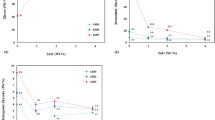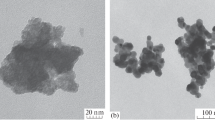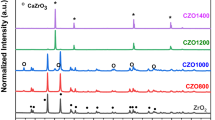Abstract
Zircon samples without and with secondary chemical alteration from diverse sources were subjected to heat treatment at 1400 °C for 96 h. Resulting new phases and textures suggest that decomposition of zircon into component oxides occurred in all experiments to various degrees. The crucible material was found to have a strong influence on the extent of breakdown, especially in the case of altered starting materials. In this study the progressive stages of the breakdown of zircon grains are described. The factors that may govern the decomposition are discussed, including radiation damage, secondary alteration and external reaction conditions (sample container, atmosphere). Alumina crucibles should generally be avoided in dry annealing of zircon, to minimise uncontrolled breakdown into oxides.





Similar content being viewed by others
References
Ansdell KM, Kyser TK (1993) Textural and chemical changes undergone by zircon during the Pb-evaporation technique. Am Mineral 78:36–41
Barreiro P, Rey P, Souto A, Guitián F (2009) Porous stabilized zirconia coatings on zircon using volatility diagrams. J Eur Ceram Soc 29:653–659
Begg BD, Hess NJ, Weber WJ, Conradson SD, Schweiger MJ, Ewing RC (2000) XAS and XRD study of annealed 238Pu— and 239Pu-substituted zircons (Zr0.92Pu0.08SiO4). J Nucl Mat 278:212–224
Butterman WC, Foster WR (1967) Zircon stability and the ZrO2-SiO2 phase diagram. Am Mineral 52:880–885
Capitani GC, Leroux H, Doukhan JC, Ríos S, Zhang M, Salje EKH (2000) A TEM investigation of natural metamict zircons: structure and recovery of amorphous domains. Phys Chem Minerals 27:545–556
Carrez P, Forterre C, Braga D, Leroux H (2003) Phase separation in metamict zircon under electron irradiation. Nucl Instrum Meth B 211:549–555
Chapman HJ, Roddick JC (1994) Kinetics of Pb release during the zircon evaporation technique. Earth Planet Sci Lett 121:601–611
Colombo M, Chrosch J (1998) Annealing of natural metamict zircons: II high degree of radiation damage. Radiat Phys Chem 53:563–566
Colombo M, Chrosch J, Salje EKH (1999) Annealing metamict zircon: a powder X-ray diffraction study of a highly defective phase. J Am Ceram Soc 82:2711–2716
Davis DW (2007) Sub-m.y. age resolution for Precambrian igneous events by thermal extraction (TE-TIMS) Pb dating of zircon: Application to progressive crystallization of the 1849 Ma Sudbury impact melt. Geochim Cosmochim Acta 71:A206
Ellsworth S, Navrotsky A, Ewing RC (1994) Energetics of radiation damage in natural zircon (ZrSiO4). Phys Chem Minerals 21:140–149
Ewing RC, Meldrum A, Wang L, Weber WJ, Corrales LR (2003) Radiation effects in zircon. In: Hanchar JM, Hoskin PWO (eds) Zircon. Mineral. Soc. Am., Washington, D.C., pp 387–425
Fritsch M, Klemm H, Herrmann M, Schenk B (2006) Corrosion of selected ceramic materials in hot gas environment. J Eur Ceram Soc 26:3557–3565
Gardner RA, Buchanan RC (1975) High temperature loss of silica from zircon and refractory silicates. J Electrochem Soc 122:205–211
Geisler T (2002) Isothermal annealing of partially metamict zircon: evidence for a three-stage recovery process. Phys Chem Miner 29:420–429
Geisler T, Pidgeon RT, van Bronswijk W, Kurtz R (2002) Transport of uranium, thorium, and lead in metamict zircon under low-temperature hydrothermal conditions. Chem Geol 191:141–154
Geisler T, Pidgeon RT, Kurtz R, van Bronswijk W, Schleicher H (2003a) Experimental hydrothermal alteration of partially metamict zircon. Am Mineral 88:1496–1513
Geisler T, Rashwan AA, Rahn MKW, Poller U, Zwingmann H, Pidgeon RT, Schleicher H, Tomaschek F (2003b) Low-temperature hydrothermal alteration of natural metamict zircons from the Eastern Desert, Egypt. Mineral Mag 67:485–508
Hanchar JM, Finch RJ, Hoskin PWO, Watson EB, Cherniak DJ, Mariano AN (2001) Rare earth elements in synthetic zircon: Part 1. Synthesis, and rare earth element and phosphorus doping. Am Mineral 86:667–680
Kaiser A, Lobert M, Telle R (2008) Thermal stability of zircon (ZrSiO4). J Eur Ceram Soc 28:2199–2211
Kamaev DN, Archugov SA, Mikhailov GG (2005) Study and thermodynamic analysis of the ZrO2–SiO2 system. Russ J Appl Chem 78:200–203
Kim H, McIntyre PC (2002) Spinodal decomposition in amorphous metal–silicate thin films: Phase diagram analysis and interface effects on kinetics. J Appl Phys 92:5094–5102
Kober B (1986) Whole-grain evaporation for 207Pb/206Pb-age-investigations on single zircons using a double-filament thermal ion source. Contrib Mineral Petrol 93:482–490
Kober B (1987) Single-zircon evaporation combined with Pb+ emitter bedding for 207Pb/206Pb-age investigations using thermal ion mass spectrometry, and implications to zirconology. Contrib Mineral Petrol 96:63–71
Lucovsky G, Rayner GBJ (2000) Microscopic model for enhanced dielectric constants in low concentration SiO2-rich noncrystalline Zr and Hf silicate alloys. Appl Phys Lett 77:2912–2914
Lumpkin GR (2001) Alpha-decay damage and aqueous durability of actinide host phases in natural systems. J Nucl Mater 289:136–166
Mattinson JM (2005) Zircon U–Pb chemical abrasion (“CA–TIMS”) method: Combined annealing and multi-step partial dissolution analysis for improved precision and accuracy of zircon ages. Chem Geol 220:47–66
McLaren AC, Fitz Gerald JD, Williams IS (1994) The microstructure of zircon and its influence on the age determination from Pb/U isotopic ratios measured by ion microprobe. Geochim Cosmochim Acta 58:993–1005
Mitsuhashi T, Ichihara M, Tatsuke U (1974) Characterization and stabilization of metastable tetragonal ZrO2. J Am Ceram Soc 57:97–101
Monaghan S, Greer JC, Elliott SD (2005) Thermal decomposition mechanisms of hafnium and zirconium silicates at the atomic scale. J Appl Phys 97:114911
Mursic Z, Vogt T, Frey F (1992) High-temperature neutron powder diffraction study of ZrSiO4 up to 1900 K. Acta Crystallogr B 48:584–590
Nasdala L, Wenzel M, Vavra G, Irmer G, Wenzel T, Kober B (2001) Metamictisation of natural zircon: accumulation versus thermal annealing of radioactivity-induced damage. Contrib Mineral Petrol 141:125–144
Nasdala L, Lengauer CL, Hanchar JM, Kronz A, Wirth R, Blanc P, Kennedy AK, Seydoux-Guillaume A-M (2002) Annealing radiation damage and the recovery of cathodoluminescence. Chem Geol 191:121–140
Nasdala L, Reiners PW, Garver JI, Kennedy AK, Stern RA, Balan E, Wirth R (2004) Incomplete retention of radiation damage in zircon from Sri Lanka. Am Mineral 89:219–231
Nasdala L, Hofmeister WG, Norberg N, Mattinson JM, Corfu F, Dörr W, Kamo SL, Kennedy AK, Kronz A, Reiners PW, Frei D, Kosler J, Wan YS, Götze J, Häger T, Kröner A, Valley JW (2008) Zircon M257 — a homogeneous natural reference material for the ion microprobe U–Pb analysis of zircon. Geostand Geoanal Res 32:247–265
Nasdala L, Kronz A, Wirth R, Váczi T, Pérez-Soba C, Willner A, Kennedy AK (2009) The phenomenon of deficient electron microprobe totals in radiation-damaged and altered zircon. Geochim Cosmochim Acta 73:1637–1650
O’Neill HSC (2006) Free energy of formation of zircon and hafnon. Am Mineral 91:1134–1141
Pavlik RS, Holland HJ, Payzant EA (2001) Thermal decomposition of zircon refractories. J Am Ceram Soc 84:2930–2936
Peña P, de Aza S (1984) The zircon thermal behavior: effect of impurities. Part 1. J Mater Sci 19:135–142
Pérez-Soba C, Villaseca C, González del Tánago J, Nasdala L (2007) The composition of zircon in the peraluminous Hercynian granites of the Spanish Central System batholith. Can Mineral 45:509–527
Putnis A (2002) Mineral replacement reactions: from macroscopic observations to microscopic mechanisms. Mineral Mag 66:689–708
Wang WY, Scarratt K, Emmett JL, Breeding CM, Douthit TR (2006) The effects of heat treatment on zircon inclusions in Madagascar sapphires. Gems Gemol 42:134–150
Wanthanachaisaeng B, Häger T, Hofmeister W, Nasdala L (2006) Raman- und fluoreszenz-spektroskopische Eigenschaften von Zirkon-Einschlüssen in chrom-haltigen Korunden aus Ilakaka und deren Veränderung durch Hitzebehandlung. Z Dt Gemmol Ges 55:123–136
Wiedenbeck M, Hanchar JM, Peck WH, Sylvester P, Valley J, Whitehouse M, Kronz A, Morishita Y, Nasdala L, Fiebig J, Franchi I, Girard JP, Greenwood RC, Hinton R, Kita N, Mason PRD, Norman M, Ogasawara M, Piccoli PM, Rhede D, Satoh H, Schulz-Dobrick B, Skar O, Spicuzza MJ, Terada K, Tindle A, Togashi S, Vennemann T, Xie Q, Zheng YF (2004) Further characterisation of the 91500 zircon crystal. Geostand Geoanal Res 28:9–39
Wirth R (2004) Focused Ion Beam (FIB): A novel technology for advanced application of micro- and nanoanalysis in geosciences and applied mineralogy. Eur J Mineral 16:863–876
Zhang M, Salje EKH, Capitani GC, Leroux H, Clark AM, Schluter J, Ewing RC (2000) Annealing of α-decay damage in zircon: a Raman spectroscopic study. J Phys: Condens Mat 12:3131–3148
Zhao SK, Huang Y, Wang CA, Huang XX, Guo JK (2003) Mullite formation from reaction sintering of ZrSiO4/α-Al2O3 mixtures. Mater Lett 57:1716–1722
Acknowledgements
Samples studied in this research were kindly provided by J.M. Hanchar (synthetic zircon), M. Wiedenbeck (91500), W. Hofmeister (M127, M144, M146, M257), and C. Pérez-Soba (87165). Thanks are due to A. Wagner for the excellent sample preparation, and to B. Ullrich for obtaining a BSE image of an annealed La Pedriza zircon. We are grateful to I. Dódony and D.W. Davis for helpful discussions and suggestions. The constructive reviews by J.M. Hanchar and an anonymous expert, and detailed comments by associate editor A. Möller, greatly contributed to the manuscript. Partial funding for this study was provided by the European Commission through contract no. MEXC-CT-2005-024878 and by the Austrian Science Fund (FWF) through grant no. P20028-N10.
Author information
Authors and Affiliations
Corresponding author
Additional information
Editorial handling: A. Möller
Rights and permissions
About this article
Cite this article
Váczi, T., Nasdala, L., Wirth, R. et al. On the breakdown of zircon upon “dry” thermal annealing. Miner Petrol 97, 129–138 (2009). https://doi.org/10.1007/s00710-009-0087-9
Received:
Accepted:
Published:
Issue Date:
DOI: https://doi.org/10.1007/s00710-009-0087-9




